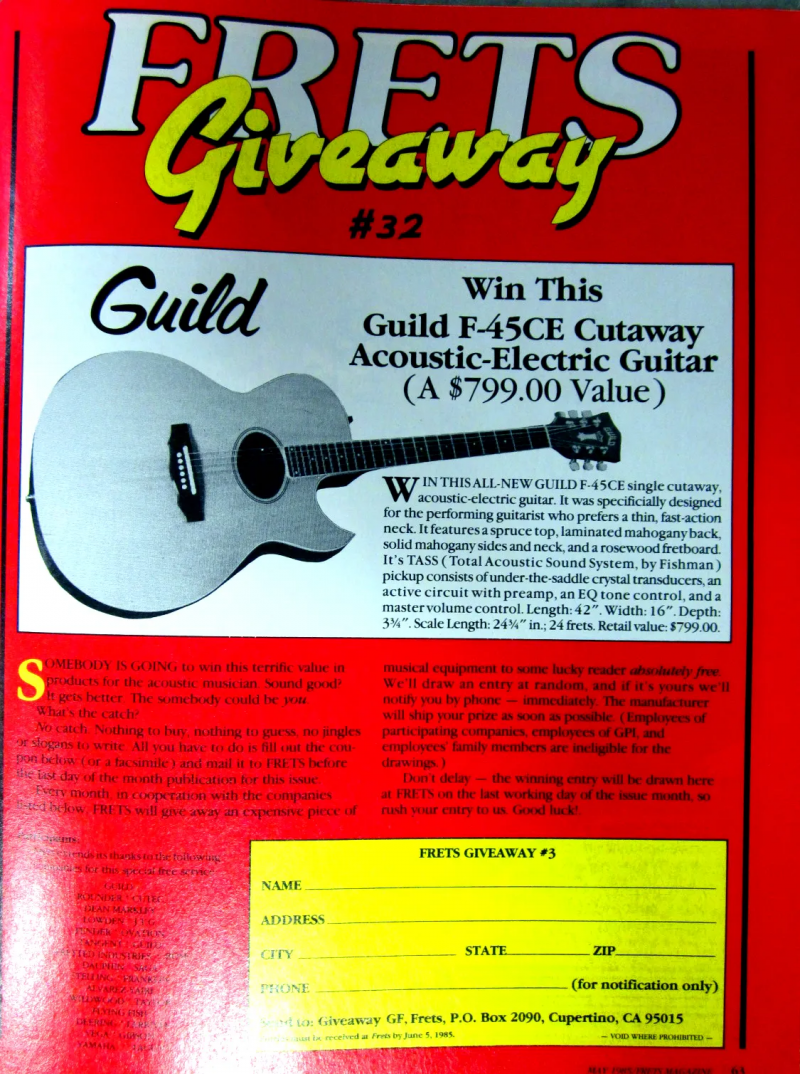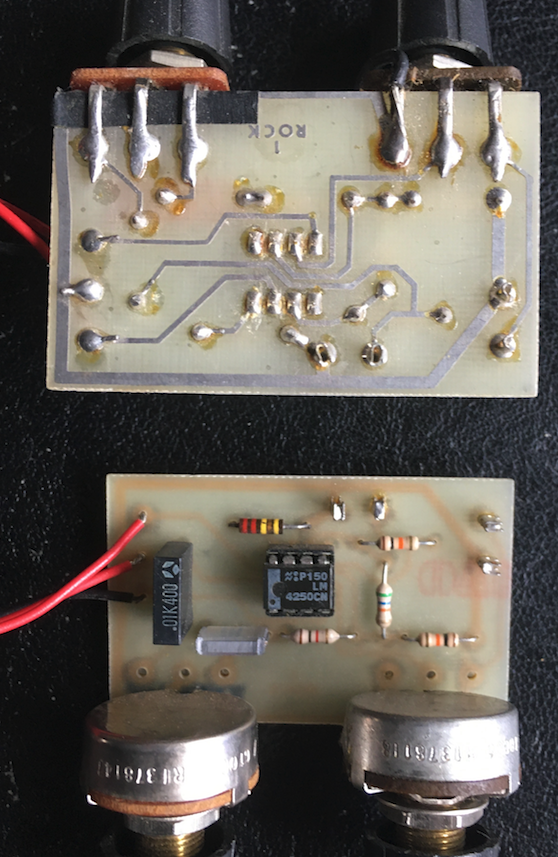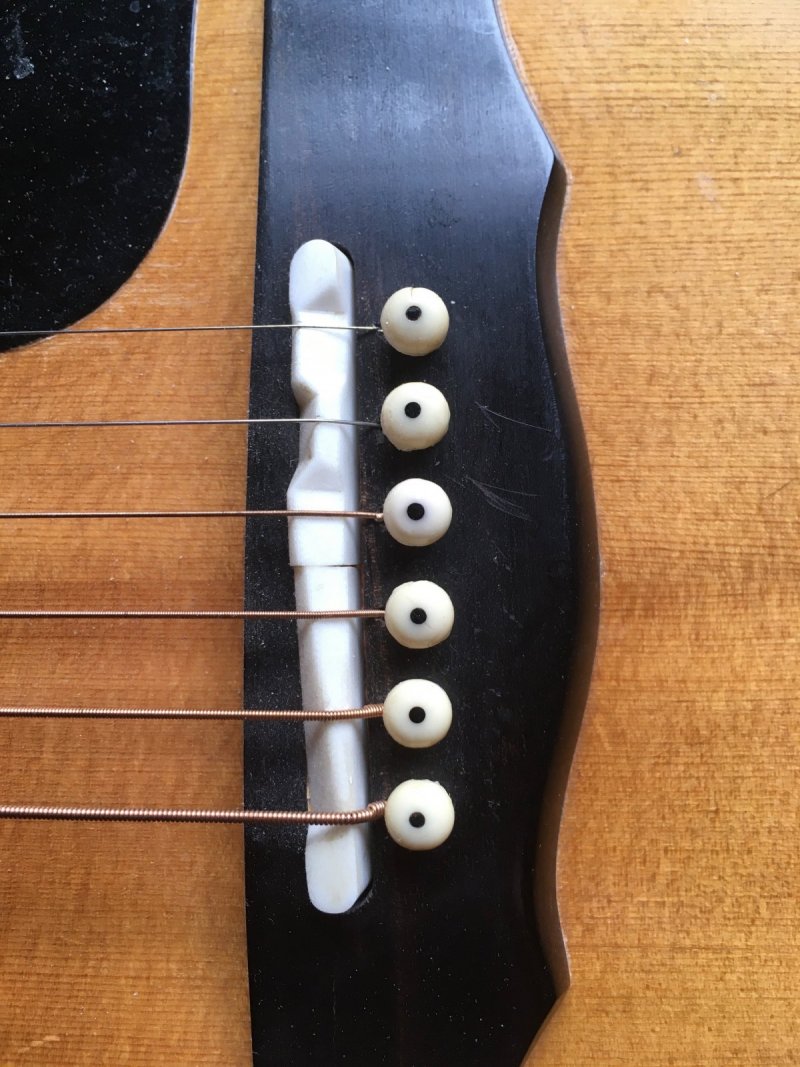1983/1984 seems to be the time when Guild started to produce guitars with built-in under saddle pickups and preamps by one of the pioneers of this technology, Larry Fishman. I recently bought a VERY used Guild MKS10CE classical solid body guitar circa 1984. This guitar was in rough shape. The body and neck had many dings, chips and finish checking, deep finger worn area in the top between the sound hole and bridge, tacky non-original pickguard. But it has many nice features as well; one of a small production run, straight neck, good frets, spruce top, routed mahogany body with black binding, mahogany neck, 2" wide rosewood fingerboard, slotted headstock with rosewood overlay and cream "GUILD" inlay.
This guitar also has, from what I've learned from a couple of interesting discussions here at LTG as well from some web info, a Fishman built electronic pickup system from the early days of under saddle pickup technology. This system was also installed in the F45CE guitar from the same time period. I don't know for sure but I would assume the FS46CE and FS46CE/12 would have had this system. The reference info refers to a TASS pickup system. I don't know what it stands for but from a 2008 Tech Shop post by Grot it looks like a very early version of the Thinline pickup Larry Fishman developed for Martin a few years after his initial work with Guild. If I remember correctly Grot's guitar was one of the first MKS10CE guitars. My purchase is also early in the line but has a pickup designed more like a crude version of the Thinline pickup but with a center wire connection, not the typical end connection construction. It also seems to be wrapped in copper type shielding foil. Now this could be a replacement pickup but as I said it is not as refined as the Thinline pickups. As many people have said concerning these early pickups, including Hans Moust, I had spent an afternoon trying to get a good string to string balance. In the end I made a hardwood shim to fit the bottom of the bridge slot as a flat base for the pickup. I then reluctantly cut the saddle in half to match the pickup shape, strings 4-6 on one half and 1-3 on the other. This gave me a very good balance and higher output across all strings.
The built-in preamp board was another interesting research project. The board is labeled "LFT-EQ1", (Larry Fishman Transducers ?). I have included photos and a schematic I made for anyone interested.
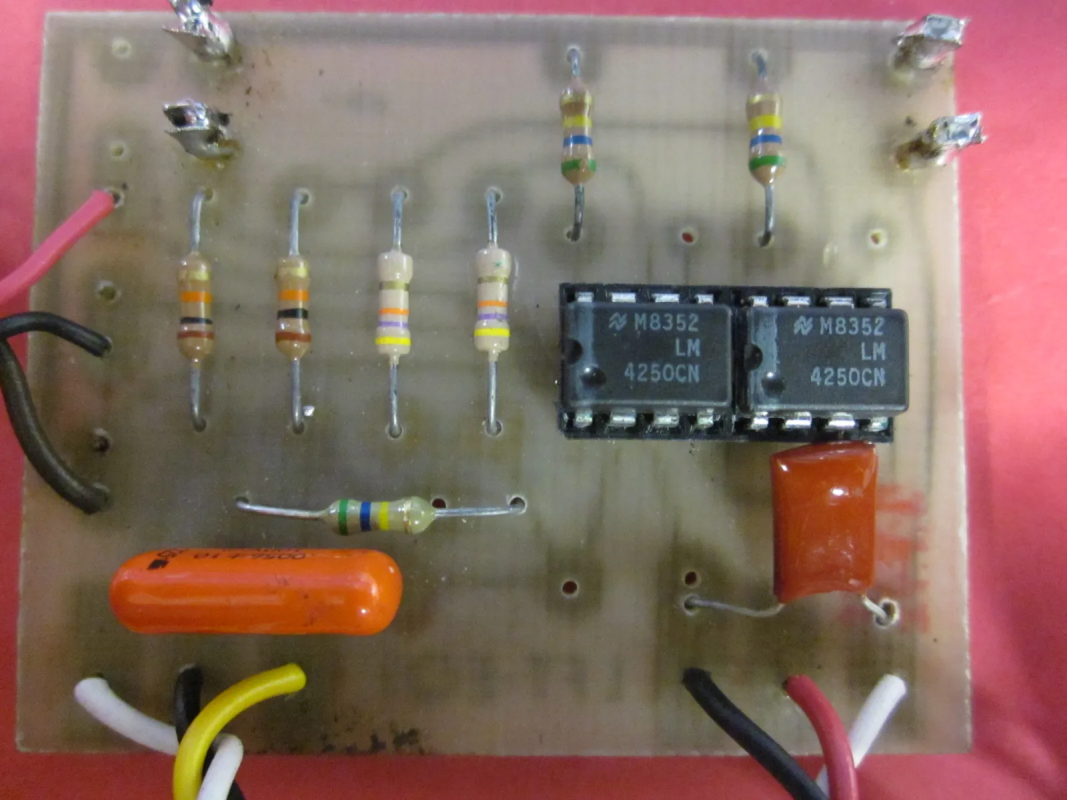
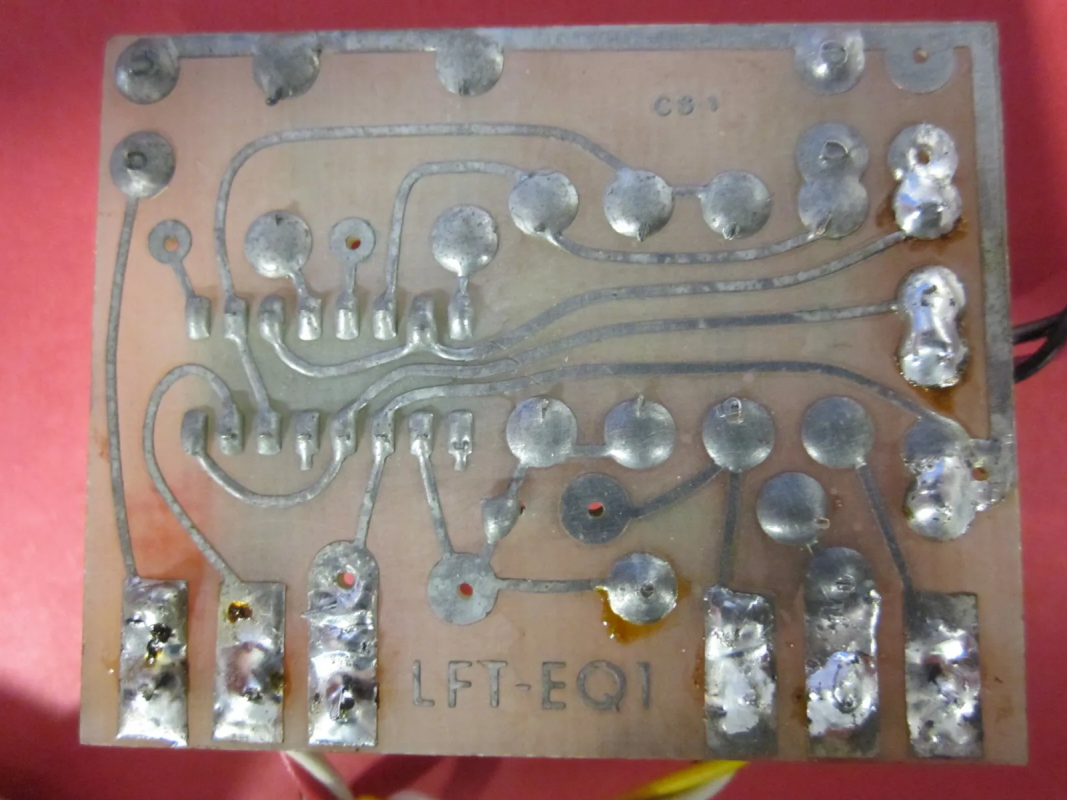
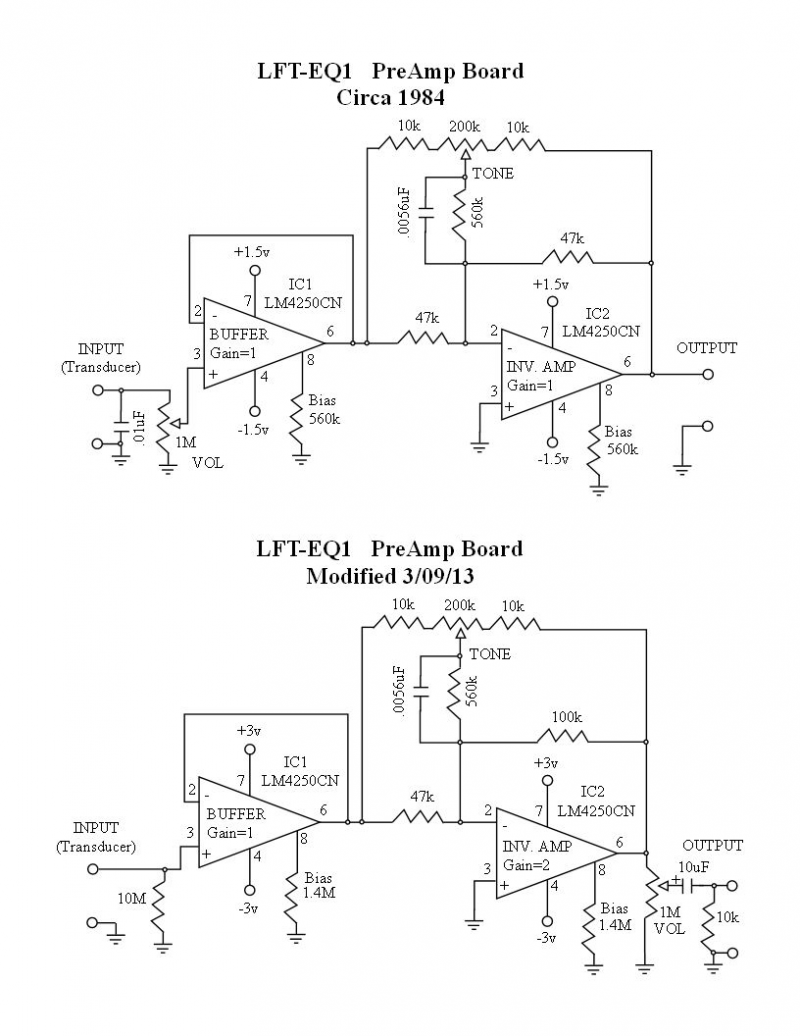
I will say the output of this board was a little disappointing, especially before I made adjustment to the pickup as I described above. Now the basic circuit certainly has some good aspects despite the bad reputation it and it's 3 volt operation have. The stock configuration is designed for a gain of approx. 1x. The 3 volt supply is workable in this situation and using two "AAA" batteries gives acceptable service life. The two opamp IC's chosen, LM4250, have adjustable bias current consumption as well as almost rail to rail signal operation enabling them to work well with a low voltage power supply. They are also operated with a +/- supply, (+1.5v and -1.5v), with a center tap ground as opposed to a single supply operation. This means that the battery holder had to have a third wire added to create the ground between the two batteries for the circuit.
With a few small modifications to this board I am now getting a very full freq. range, including great bass and high end response, along with low noise and high output operation. The first thing I did was to double the supply voltage to 6 volts, (+3v and -3v), using four "AAA" batteries to enable me to have enough headroom to raise the gain. An enclosed battery holder from Radio Shack, p/n-2700411, does a fine job of holding these batteries in the small compartment available in the guitar. I did have to modify the battery holder by adding the center tap wire as the original battery holder had and bypassed the built-in power switch. The opamp gain setting resistors were also changed to set the bias current back to the original value compensating for the greater supply voltage. This will give any guitar amplifier/EQ box more than enough signal to work with especially running it into a nice tube amplifier (I admit that I'm biased, I make Hearth Amplifiers all tube amplifiers and effects). The next thing to do was to free up the transducer loading to produce a full range output by removing the 1M volume control and .01uF capacitor from across the input and replace them with a 10M resistor. The gain was then increased to approx. 2x by changing the 47k opamp feedback resistor to 100k. I then put the 1M volume control across the output of the second opamp. From the wiper of the volume control I added a 10uF capacitor and 10k load resistor to ground. This gives a low enough output impedance to drive a 100k to 1M amplifier/EQ box input. These minor changes show the basics of this early Fishman design to be solid. ( This system currently does not have a power switch in the jack or on the guitar. The same as the original design, it is powered all the time. )
As far as the cosmetics of this guitar go the one thing I could not live with was the pickguard the previous owner had installed. It would have been ideal to remove the pickguard and leave it at that, as a classical guitar should be. However there was more finish removed and top wear under the pickguard as well as behind it. My solution was to give it a proper Guild shaped pickguard. With the help of another LTG post this one in Acoustic/Acoustic Electric in 2013 by DCannon I was able to find an appropriately thin and nice colored tortoise material to use to make a pickguard. I based the design on a Guild dread pickguard. The tough part was to move the sound hole cutout forward due to the fact that classical guitars have a bridge that is located further toward the rear of the body. After moving the sound hole cutout the outline of the pickguard had to be modified a bit to look right. I think it came out all right but since Guild hasn't to my knowledge put a stock pickguard on a classical guitar I had to guess what they might have done in 1984.
Please let me know of any incorrect assumptions or information I've provided above. My goal is to help fellow LTG members with information that we can all build from just like the posts that have helped me so much.
Thanks again to all.
This guitar also has, from what I've learned from a couple of interesting discussions here at LTG as well from some web info, a Fishman built electronic pickup system from the early days of under saddle pickup technology. This system was also installed in the F45CE guitar from the same time period. I don't know for sure but I would assume the FS46CE and FS46CE/12 would have had this system. The reference info refers to a TASS pickup system. I don't know what it stands for but from a 2008 Tech Shop post by Grot it looks like a very early version of the Thinline pickup Larry Fishman developed for Martin a few years after his initial work with Guild. If I remember correctly Grot's guitar was one of the first MKS10CE guitars. My purchase is also early in the line but has a pickup designed more like a crude version of the Thinline pickup but with a center wire connection, not the typical end connection construction. It also seems to be wrapped in copper type shielding foil. Now this could be a replacement pickup but as I said it is not as refined as the Thinline pickups. As many people have said concerning these early pickups, including Hans Moust, I had spent an afternoon trying to get a good string to string balance. In the end I made a hardwood shim to fit the bottom of the bridge slot as a flat base for the pickup. I then reluctantly cut the saddle in half to match the pickup shape, strings 4-6 on one half and 1-3 on the other. This gave me a very good balance and higher output across all strings.
The built-in preamp board was another interesting research project. The board is labeled "LFT-EQ1", (Larry Fishman Transducers ?). I have included photos and a schematic I made for anyone interested.



I will say the output of this board was a little disappointing, especially before I made adjustment to the pickup as I described above. Now the basic circuit certainly has some good aspects despite the bad reputation it and it's 3 volt operation have. The stock configuration is designed for a gain of approx. 1x. The 3 volt supply is workable in this situation and using two "AAA" batteries gives acceptable service life. The two opamp IC's chosen, LM4250, have adjustable bias current consumption as well as almost rail to rail signal operation enabling them to work well with a low voltage power supply. They are also operated with a +/- supply, (+1.5v and -1.5v), with a center tap ground as opposed to a single supply operation. This means that the battery holder had to have a third wire added to create the ground between the two batteries for the circuit.
With a few small modifications to this board I am now getting a very full freq. range, including great bass and high end response, along with low noise and high output operation. The first thing I did was to double the supply voltage to 6 volts, (+3v and -3v), using four "AAA" batteries to enable me to have enough headroom to raise the gain. An enclosed battery holder from Radio Shack, p/n-2700411, does a fine job of holding these batteries in the small compartment available in the guitar. I did have to modify the battery holder by adding the center tap wire as the original battery holder had and bypassed the built-in power switch. The opamp gain setting resistors were also changed to set the bias current back to the original value compensating for the greater supply voltage. This will give any guitar amplifier/EQ box more than enough signal to work with especially running it into a nice tube amplifier (I admit that I'm biased, I make Hearth Amplifiers all tube amplifiers and effects). The next thing to do was to free up the transducer loading to produce a full range output by removing the 1M volume control and .01uF capacitor from across the input and replace them with a 10M resistor. The gain was then increased to approx. 2x by changing the 47k opamp feedback resistor to 100k. I then put the 1M volume control across the output of the second opamp. From the wiper of the volume control I added a 10uF capacitor and 10k load resistor to ground. This gives a low enough output impedance to drive a 100k to 1M amplifier/EQ box input. These minor changes show the basics of this early Fishman design to be solid. ( This system currently does not have a power switch in the jack or on the guitar. The same as the original design, it is powered all the time. )
As far as the cosmetics of this guitar go the one thing I could not live with was the pickguard the previous owner had installed. It would have been ideal to remove the pickguard and leave it at that, as a classical guitar should be. However there was more finish removed and top wear under the pickguard as well as behind it. My solution was to give it a proper Guild shaped pickguard. With the help of another LTG post this one in Acoustic/Acoustic Electric in 2013 by DCannon I was able to find an appropriately thin and nice colored tortoise material to use to make a pickguard. I based the design on a Guild dread pickguard. The tough part was to move the sound hole cutout forward due to the fact that classical guitars have a bridge that is located further toward the rear of the body. After moving the sound hole cutout the outline of the pickguard had to be modified a bit to look right. I think it came out all right but since Guild hasn't to my knowledge put a stock pickguard on a classical guitar I had to guess what they might have done in 1984.
Please let me know of any incorrect assumptions or information I've provided above. My goal is to help fellow LTG members with information that we can all build from just like the posts that have helped me so much.
Thanks again to all.
Last edited by a moderator:
